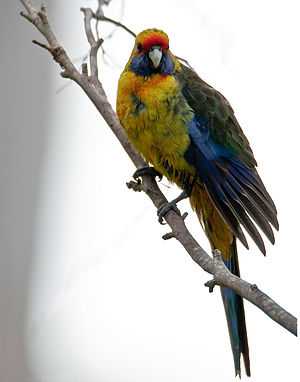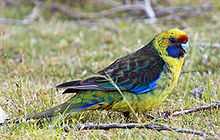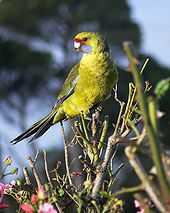Green rosella
| Green rosella | |
|---|---|
 | |
| Female in Tasmania, Australia | |
| Conservation status | |
| Scientific classification | |
| Kingdom: | Animalia |
| Phylum: | Chordata |
| Class: | Aves |
| Order: | Psittaciformes |
| Superfamily: | Psittacoidea |
| Family: | Psittaculidae |
| Subfamily: | Platycercinae |
| Tribe: | Platycercini |
| Genus: | Platycercus |
| Species: | P. caledonicus |
| Binomial name | |
| Platycercus caledonicus (Gmelin, 1788) | |
The green rosella or Tasmanian rosella (Platycercus caledonicus) is endemic to Tasmania and Bass Strait islands. At 37 cm (14.5 in) long it is the largest species of the rosella genus, Platycercus. The male and female are generally similar in plumage, being predominantly black, green, and yellow in colour with a red band above the beak and blue cheeks; however, some females have red-orange colouration on the front of their necks. Its diet is composed of seeds, fruit, berries and flowers, as well as insects and insect larvae.
Taxonomy
The green rosella was described by the German naturalist Johann Friedrich Gmelin in 1788. The species specific epithet was derived from the mistaken belief the bird was collected from New Caledonia.[2] Alternate common names include Tasmanian rosella, yellow-bellied or yellow-breasted parakeet, and mountain parrot.[3]
Description

Measuring 37 cm (14.5 in) in length, the adult green rosella has a yellow head and underparts with blue cheeks and red frontal band above the beak. The feathers of the back and wings are black with narrow green margins, the is rump yellow-olive, and the long tail is green with blue outer feathers. The wings are green and violet blue. The irises are dark brown and the bill is pale-grey. The legs are grey. The male and female have similar external appearances, except the female may have an orange-red hue in the feathers on the front of the neck, and the female has a smaller beak than the male. and Juvenile birds have an under-wing stripe, which is not present in the adults. Juveniles have dull yellow-green head and underparts and dull green upperparts.[4][5]
Distribution and habitat
The green rosella is found across Tasmania and Bass Strait islands, and occurs in most habitats with some form of tree cover up to 1500 m above sea level.[4][5]
Feeding

The green rosella is predominantly herbivorous, consuming seeds, berries, nuts and fruit, as well as flowers, but may also eat insect larvae and insects such as psyllids. They have also partaken of the berries of the common hawthorn (Crataegus monogyna), as well as Coprosma and Cyathodes, and even leaf buds of the common osier (Salix viminalis).[4] The seeds of the silver wattle (Acacia dealbata) are also eaten.[6]
Breeding
The breeding season is October to January, with one brood. The nesting site is usually a hollow over 1 m (3 ft) deep in a tree trunk anywhere up to 30 m (100 ft) above the ground. A clutch of four or five white and slightly shiny eggs, measuring 30 x 24 mm, is laid.[7] The nestlings leave the nest around five weeks after hatching and remain with their parents for another month.
Aviculture
The green rosella is reported to be hardier and easier to keep in captivity than other rosellas.[8]
References
- ↑ BirdLife International (2012). "Platycercus caledonicus". IUCN Red List of Threatened Species. Version 2013.2. International Union for Conservation of Nature. Retrieved 26 November 2013.
- ↑ Sindel, Stan; Gill, James (1999). Australian Broad-tailed Parrots. Chipping Norton (Sydney): Surrey Beatty & Sons. ISBN 0-9587727-6-2.
- ↑ Lendon, p. 186
- ↑ 4.0 4.1 4.2 Forshaw, Joseph M.; Cooper, William T. (1981) [1973, 1978]. Parrots of the World (corrected second edition ed.). David & Charles, Newton Abbot, London. p. 233. ISBN 0-7153-7698-5.
- ↑ 5.0 5.1 Forshaw (2006). plate 53.
- ↑ Lendon, p. 188
- ↑ Beruldsen, G (2003). Australian Birds: Their Nests and Eggs. Kenmore Hills, Qld: self. p. 246. ISBN 0-646-42798-9.
- ↑ Lendon, p. 189
Cited texts
- Lendon, Alan H. (1973). Australian Parrots in Field and Aviary (2nd. ed). Sydney: Angus and Robertson. ISBN 0-207-12424-8.
- Forshaw, Joseph M. (2006). Parrots of the World; an Identification Guide. Illustrated by Frank Knight. Princeton University Press. ISBN 0-691-09251-6.
External links
| Wikimedia Commons has media related to Platycercus caledonicus. |
| Wikispecies has information related to: Platycercus caledonicus |
